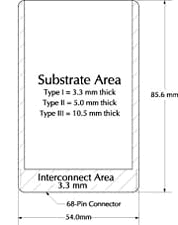2.0 Laptop and Portable Devices
2.1 Identify the fundamental principles of using laptops and portable devices
Expansion slots (e.g. PCMCIA I, II and III, card and express bus)
All PC cards use same connecting interface with 68 pins. All are 85.6 mm long and 54.0 mm wide.
The original standard was defined for both 5 volt and 3.3 volt cards. The 3.3 V cards have a key on the side to protect them from being damaged by being put into a 5 V-only slot. Some cards and some slots operate at both voltages as needed.

Type I: These cards are 3.3 mm thick. They are primarily used for adding RAM ROM to a notebook PC. They accommodate 16-bit interface.
Type II: These cards are 5.0 mm thick. These cards are often used for modem, fax, SCSI, and LAN cards.
The Type III: Type III cards are 10.5mm thick, sufficiently large for portable disk drives.They can also accommodate interface cards with full-size connectors that do not require dongles (as is commonly required with type II interface cards).
Differences between PC card slots
As with the physical PC cards, PC slots also come in three sizes:
Most notebook computer systems come with two PC card slots that allow for the use of two type I or type II PC cards and one type III PC card. The PC card slots are stacked with one above the other. Usually, type III PC cards fit only in the bottom slot.
CardBus: The older PC card standard was 16 bits at 8MHz. Cardbus is an extension of the PCMCIA standard, which expands the bus bandwidth and throughput to 32 bits at 33MHz.. PCMCIA card version 5 and above comply with Cardbus standard. Cardbus is analogous to the PCI slots in desktops, while the older PC card standard is analogous to ISA. The newer cardbus slot can accommodate an older 16-bit PC card, but it doesn't work other way round.
Express Cardbus: ExpressCard is being built on the USB 2.0 and PCI Express buses. It increases speed and reduces the cost and complexity of the PCM bus. The complexity is eliminated by doing away with the PCMCIA Host Controller. ExpressCard has a direct connection to the system bus over a PCI Express x1 lane or USB 2.0. , whereas CardBus utilizes an interface controller to interface with PCI. The ExpressCard has a maximum throughput of 2.5 Gbit/s through PCI Express or 480 Mbit/s through USB 2.0 dedicated for each slot, versus CardBus's shared 1066 Mbit/s bandwidth.
Disclaimer: Simulationexams.com is not affiliated with any certification vendor, and Sim-Ex™ Practice Exams are written independently by SimulationExams.com and not affiliated or authorized by respective certification providers. Sim-Ex™ is a trade mark of SimulationExams.com or entity representing Simulationexams.com.A+™ is a trademark of CompTIA® organization.